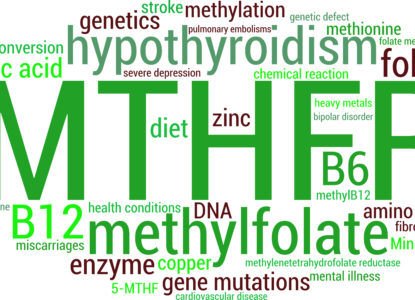Concerned About High Homocysteine? These Genes Could be to Blame
Genes Mentioned

Homocysteine is a vital molecule required for numerous processes within the cells of our body to ensure good health. However, as with much in life, sometimes you can have too much of a good thing. According to Boston Heart Diagnostics, anything above 15 umol/L is considered elevated, and based on their reference ranges, you really want that number below 10.
Homocysteine is typically converted into methionine, or cysteine, both of which are less harmful when in excess, and are also required for many cellular processes. The major driver of this conversion is an enzyme called methionine synthase (MS), although there are other pathways involved as well. Methionine synthase generates methionine from homocysteine using 5-MTHF as a donor for a methyl group. With a lack of 5-MTHF, as occurs in those with reduced MTHFR function, this reaction stalls, and homocysteine accumulates.

Figure 1 – The one carbon pathway and methionine cycle together form part of the great methylation cycle.
Many of you will likely have heard of homocysteine in relation to the MTHFR (Methylene tetrahydrofolate reductase) gene and two key SNPs associated with it C677T and A1298C. Indeed, this gene is so important we dedicated a large post to it detailing its various activities.
Genes and SNPs that alter homocysteine levels
In the sections below, I’ll provide some details about these genes and SNPs, and perhaps more importantly, key nutritional interventions you can make. But as a starting point, if you’re worried about your genetics and homocysteine levels, then a simple blood test is available which can quickly report your homocysteine levels.
Something that often gets lost in the excitement surrounding MTHFR is that there are actually several other genes, with associated SNPs, that can also alter homocysteine levels.
It’s certainly not the only lab that reports on homocysteine, but we recommend Boston Heart Diagnostics. Boston Heart Labs provide a wealth of health information in addition to homocysteine, including Lp(a) numbers, LDL-P, and MTHFR status to name a few.
#1. MTHFR
As discussed above, MTHFR, and its two key SNPs, is perhaps the most well known member of the one-carbon pathway and greater methylation pathway. I cover the science behind these mutations in a previous post, so rather than covering it all in detail again I’ll provide the link and give a brief summary.
The two SNPs we’re interested in are rs1801133 or C677T and rs1801131 or A1298C which are detailed in the table below.
| Gene | SNP ID | SNP Name | Major Allele/Minor Allele (Risk) |
|---|---|---|---|
| MTHFR | rs1801133 | C677T | C/T |
| rs1801131 | A1298C | A/C |
Those carrying the ‘T’ allele of rs1801133 show a reduction in MTHFR enzyme activity of between 30-70%; which leads to a reduction in the conversion of 5,10-MeTHF to 5-MTHF.
It is thought that this occurs because the enzyme is rendered more heat sensitive and also has a reduced ability to stay bound with its co-factor, vitamin B2. 7 8 The ‘C’ allele of rs1801131 also reduces the enzyme activity of MTHFR although to a lesser extent, and the mechanism remains unknown. 9
A third SNP is also commonly discussed, rs2066470 or C117T, however there is no scientific data to support any effect.

Figure 2 – MTHFR produces 5-MTHF from 5,10-MTHF, when activity is impaired the various cycles can stall leading to an accumulation of homocysteine.
Based on the figure above we can see how the two SNPs in MTHFR can lead to an accumulation of homocysteine. By limiting the production of 5-MTHF the conversion of homocysteine to methionine becomes limited, and so homocysteine accumulates. Focusing on MTHFR alone, rather than other enzymes, the obvious nutritional target is vitamin B2. As the cofactor for MTHFR, vitamin B2 allows the gene to function correctly, and for those carrying either the C677T or A1298C risk alleles, ensuring optimal MTHFR function may limit homocysteine accumulation.
#2. CBS
Moving ahead in the cycle, we get to cystathionine-beta-synthase (CBS). This enzyme functions to convert homocysteine into cysteine, limiting its harmful buildup. This pathway is one of three used to clear homocysteine accumulation.
CBS acts in conjuntion with another enzyme cystathionine-gamma-ligase (CTH) to process homocysteine into cysteine; CBS converts homocysteine into cystathionine, which is then converted into cysteine by the action of CTH. There are two SNPs of interest in CBS rs28934891 or G1330A and rs5742905 or T833C, but none of interest in CTH.
| Gene | SNP ID | SNP Name | Major Allele/Minor Allele (Risk) |
|---|---|---|---|
| CBS | rs28934891 | G1330A | G/A |
| rs5742905 | T833C | T/C |
The very rare risk ‘A’ allele of rs28934891 is associated with reduced CBS activity and an accumulation of homocysteine. 10
Whereas the risk ‘C’ allele rs5742905 is also associated with accumulation of homocysteine but the mechanism of action remains unknown in this case. 11

Figure 3 – CBS is an enzyme responsible for converting the potentially harmful homocysteine into cysteine.
Vitamin B6 is the co-factor for CBS, and so supplementation may therefore be expected to improve CBS activity converting homocysteine into cysteine. The impact of vitamin B6 on both SNPs has been directly investigated in relation to homocysteine accumulation. A strong reduction in homocysteine levels was observed in patients carrying both risk alleles following supplementation with vitamin B6 at doses of between 5-300 mg/day. 12 This example is one of the best for showing how nutritional intervention can have a direct benefit for health issues arising from genetic variations.
As a quick aside, there is another SNP of interest in CBS, rs234706 or C699T (although more correctly it should be G699A, and may appear so on your report). The exact effect this SNP has on homocysteine is unclear with some studies showing an increase in homocysteine,13 whereas others showed no change or even the opposite effect. 14 15 In the study which reported an increase in CBS activity this was associated with an accumulation of ammonia, therefore carriers may wish to consider having their serum ammonia levels assessed.
#3. SHMT1
Serine hydroxymethyltransferase 1 (SHMT1) is an enzyme of the one carbon pathway which converts THF and the amino acid serine into 5,10-MTHF, the substrate required by MTHFR. 16 There is one SNP in SHMT1 rs1979277 or C1420T.
| Gene | SNP ID | SNP Name | Major Allele/Minor Allele (Risk) |
|---|---|---|---|
| SHMT1 | rs1979277 | C1420T | C/T |
The risk ‘T’ allele of C1420T is associated with an alteration in SHMT enzyme localisation within the cell, which impairs its ability to convert 5,10-MTHF into 5-MTHF. 17 A reduction in 5-MTHF is thought to limit the activity of MTHFR which as discussed above can lead to the accumulation of homocysteine.

Figure 4 – SHMT1 controls the production of 5,10-MTHF which is in turn used by MTHFR.
As with CBS, the cofactor for SHMT1 is vitamin B6. 18 Although the risk allele ‘T’ of C1420T is not associated with reduced activity it is associated with altered localization of SHMT1 which in turn limits the availability of 5-MTHF, therefore supplementation may help maximize its activity.
#4. MTR
Methionine synthase (MS) is a key enzyme in the methionine cycle, which forms part of the wider methylation pathway. MS generates methionine from homocysteine using 5-MTHF as a donor for a methyl group. With a lack of 5-MTHF, as occurs in those with less functional MTHFR, this reaction stalls and leads to an accumulation of homocysteine. However, there is also one SNP of interest within MTR rs1805087 or A2756G.
| Gene | SNP ID | SNP Name | Major Allele/Minor Allele (Risk) |
|---|---|---|---|
| MTR | rs1805087 | A2756G | A/G |
Interestingly, although ‘G’ is the minor allele and less common it is thought to increase MS activity, as it was associated with reductions in levels of homocysteine in the blood, 19 therefore in this instance the ‘A‘ allele is classed as the risk. No studies investigating this effect further have been performed, including those at a nutritional level. However, it is known that MS uses vitamin B12 as its co-factor in order to function correctly, 20 and that this requires frequent turnover (the vitamin B12 molecule needs to be refreshed) in order to maintain function, therefore supplementation may be recommended if homocysteine accumulation suspected.
#5. MTRR
Methyltetrahydrofolate-homocysteine methyltransferase reductase (MTRR) or methionine synthase reductase (MSR) to give it its slightly easier to remember name, interacts with the previously discussed MS. MS converts homocysteine into methionine, using MTHF produced by MTHFR as a methyl donor. As discussed above the activity of MS requires vitamin B12 as a co-factor, however over time this becomes inactivated. MTRR breaks the association between methionine synthase and inactive vitamin B12, allowing a new functional vitamin B12 molecule to bind, ensuring continuing production of methionine. 21 There is one SNP within MTR associated elevated homocysteine rs1801394 or A66G.
| Gene | SNP ID | SNP Name | Major Allele/Minor Allele (Risk) |
|---|---|---|---|
| MTRR | rs1801394 | A66G | A/G |
The ‘G’ allele of rs1801394 is associated with an accumulation of homocysteine. 22 It is thought that alterations in the structure of MTRR associated with the ‘G’ allele result in a less efficient binding between MTRR and MS, meaning that the vitamin B12 molecule associated with MS is not refreshed, thus limiting its function. 23 Limited MS function then promotes an accumulation of homocysteine as its conversion to methionine is reduced.

Figure 5 – MTR and MTRR are two enzymes which regulate the conversion of the potentially harmful homocysteine into less harmful methionine.
There are no known nutrients that directly target MTRR activity, however carriers of the risk ‘G’ allele may want to consider supplementing with vitamin B12 to ensure optimal MS activity, 24 and potentially avoid excessive alcohol consumption which has been shown to inhibit MS. 25
#6. BHMT
Betaine-Homocysteine S-Methyltransferase (BHMT) is an enzyme that converts homocysteine into methionine, by replacing a hydrogen atom on homocysteine with a methyl group donated by a betaine molecule. 26 There is one SNP of interest in BHMT rs3733890 or G716A.
| Gene | SNP ID | SNP Name | Major Allele/Minor Allele (Risk) |
|---|---|---|---|
| BHMT | rs3733890 | G716A | A/G |
You may have noticed that in the above table no risk allele is marked, this is because it is currently unclear what effect either allele has on both homocysteine accumulation and disease. In one study the ‘A’ allele of G716A was associated with increased homocysteine levels in the blood, 27 however no effect on cardiac health was reported. In another study the ‘A’ allele was actually shown to provide a protective effect for cardiovascular risk, but interestingly this study did not report any alteration in homocysteine levels. 28These data suggest that there is likely some other genetic or environmental factor which is influencing BHMT activity, but what this is remains unknown.

Figure 6 – BHMT also regulates the conversion of homocysteine into methionine, providing another pathway for its breakdown.
To reduce homocysteine levels related to BHMT the obvious method is to supplement with betaine, to increase the availability of methyl groups required to convert homocysteine into methionine. 26This can be achieved directly by supplementing with betaine, or by supplementing with its precursor choline. 29 However, as the science surrounding the impact of BHMT SNPs on homocysteine is still unclear there have been no studies investigating the role of supplementation.
#7. COMT
The catechol-O-methyltransferase (COMT) enzyme is somewhat removed from the genes discussed above, but SNPs affecting its activity can also lead to homocysteine accumulation. COMT is an enzyme which inactivates neurotransmitters such as dopamine and epinephrine by attaching a methyl group into their structure which stops them binding with their various receptors. This Methyl group comes from a molecule known as S-adenosyl methionine (SAM), which formed from methionine. 30 So it’s possible to see how these complex and seemingly independent pathways can interlink. 31
| Gene | SNP ID | SNP Name | Major Allele/Minor Allele (Risk) |
|---|---|---|---|
| COMT | rs4680 | G472A | G/A |
| rs4633 | C186T | C/T |
There are two SNPs present in COMT which are of interest rs4680 or G472A and rs4633 or C186T. The risk allele ‘A‘ of rs4680 is associated with reduced (up to 75% if carrying two copies of the ‘A‘ allele) COMT activity meaning that a pool of SAM can build-up. 32 This build-up of SAM has a knock on effect causing a build-up of methionine which in turn limits the activity of MS eventually leading to an accumulation of homocysteine, which I’ve detailed in the diagram below. 33 34 Interestingly, the ‘T‘ risk allele of rs4633 does not have any direct effect on COMT activity, but can be used as a marker for the presence of the ‘A’ allele in rs4680. It was often used as a proxy marker, but due to advances in genetic testing is now not required for an accurate understanding of COMT variation.

Figure 7 – COMT is somewhat removed from the other genes discussed, existing to inactivate neurotransmitters using methyl groups from SAM.
Magnesium acts as a co-factor for COMT and so supplementation may be considered to maintain optimal COMT activity in those carrying the risk ‘A‘ allele. However, there are no studies directly investigating the impact of magnesium on COMT mutations. See also our post on the COMT Gene and Worrier vs. Warrior status.
Compound SNPs and what to do
Above I’ve described potential nutritional interventions for individual SNPs. However, it is highly likely that you will carry multiple SNPs in multiple genes, which will likely interact and often present conflicting reports. We’ve given each SNP a science grade to help you understand the relative quality of the data supporting any effect, and from this it is possible for you to develop your own nutritional plan.
We also offer consulting services for those who want help putting the puzzle pieces together.



